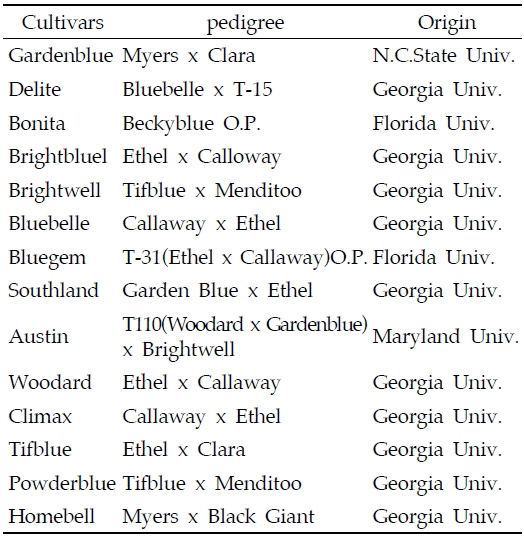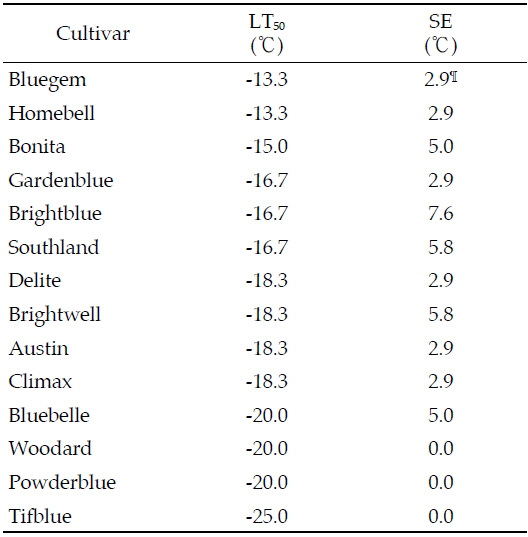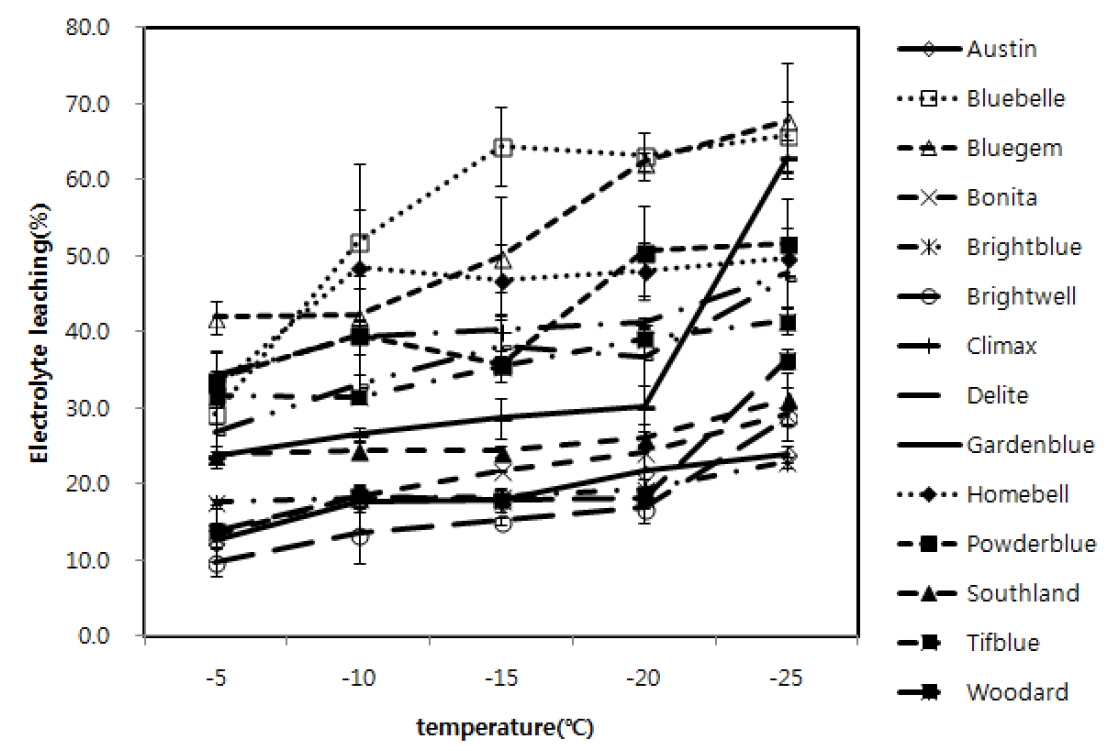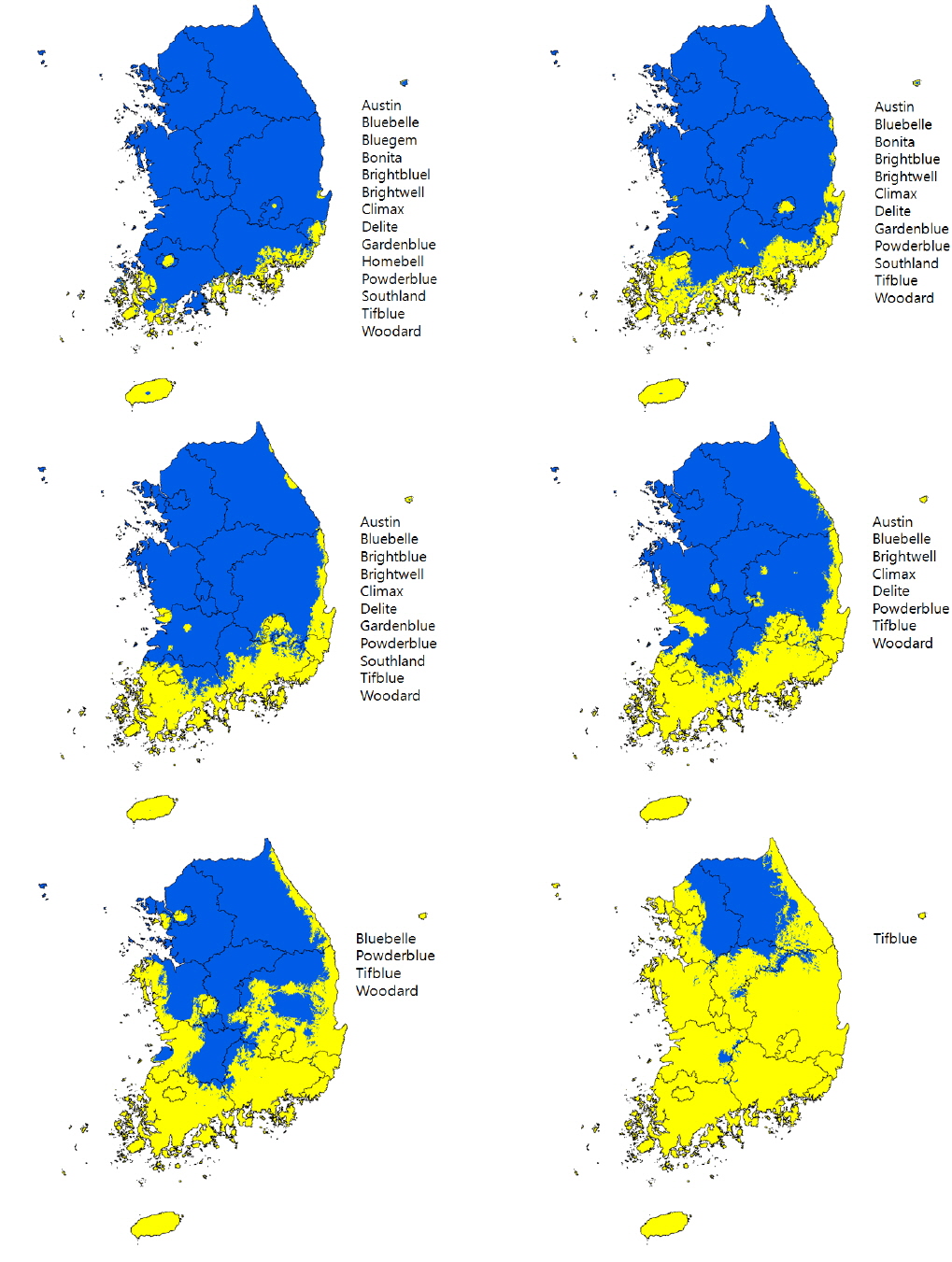



래빗아이블루베리는 북부형과 남부형 하이부쉬 블루베리와 함께 전 세계적으로 가장 많이 재배되고 있는 블루베리의 한 품종군이다. 하이부쉬 블루베리에 비해 높은 토양적응성과 다수성의 장점을 가지고 있지만, 저온 저항성이 상대적으로 낮다는 단점 역시 가지고 있다. 본 연구의 목적은 래빗아이블루베리의 품종별 꽃눈의 내동성 범위를 구명하고 그에 따른 재배안정지대를 설정하는데 두었다.
본 연구에 사용된 실험재료는 경남 남해에 소재한 국립원예특작 과학원 남해출장소 블루베리 유전자원 포장에서 1월 상순에 굵기와 꽃눈의 개수 등이 균일하도록 채취하였다. 결과지의 저온반응은 전해질 누출량을 통하여 조사하였으며, 꽃눈의 내동성은 절개한 후 씨방의 갈변율이 50%에 도달한 온도(LT50)를 경계로 구분하였다. 각 품종의 내동성을 바탕으로 재배안전지대설정은 1981~2010년까지 30년간의 극최저 기온 자료를 바탕으로 설정하였다.
래빗아이 블루베리 품종별 가지의 전해질 누출량은 온도가 낮을수록 증가하는 경향이었으며, -5℃조건에서의 전해질 누출량은 ‘Brightwell’이 가장 낮았고, ‘Bluegem’이 가장 많았다. 한편 ‘Brightblue’, ‘Brightwell’, ‘Climax’, ‘Delite’, ‘Gardenblue’, ‘Southland’ 그리고 ‘Woodard’ 품종들은 -20℃ 처리에서 전해질 누출량이 증가하였다. 래빗아이 블루베리 품종별 꽃눈의 내동성(LT50)은 ‘Bluegem’ 과 ‘Homebell’(-13.3℃)이 가장 낮았고, ‘Tifblue’(-25℃)가 가장 높았다. ‘Bonita’, Gardenblue’, ‘Brightblue’ 그리고 ‘Southland는 -15.0∼-16.7℃ 범위 내에서 내동성을 나타냈으며, ‘Delite’, ‘Brightwell’, ‘Austin’ 그리고 ‘Climax’는 -18.3℃에서, ‘Bluebelle’, ‘Woodard’ 그리고 ‘Powderblue’는 -20℃범위 내에서 내동성을 나타냈다.
본 연구는 래빗아이 블루베리 내한성 영역을 6개 구역으로 분류하였으며, ‘Tifblue’를 제외한 대부분 품종들의 재배 안전 지대는 전남 및 경남지역과 그 이남지역 이었다. 한편 본 연구의 실험실조건의 결과물이기 때문에 재배현장(노지 및 시설)에서는 다양한 요인에 의해 달라질 수 있다. 따라서 보다 정밀한 안전지대 설정을 위하여 추가적인 연구가 필요하다 사료된다.
Rabbiteye blueberry(
Bearing branches which have similar thickness and same number of floral buds were collected in the early January at the blueberry germplasm preservation plot located in Namhae Sub-station, National Institute of Horticultural and Herbal Science in Gyeongsangnam-do. Cold response of bearing branches were investigated by electrolyte leakage and freezing tolerance of floral buds were determined by ovary browning ratio of 50%(LT50). Cultivation zone was established based on mean annual extreme minimum temperature for 30 years, from1981 to2010.
The electrolyte leakage of bearing branches in rabbiteye blueberry increased as temperature decreased and was lowest in ‘Brightwell’ but highest in ‘Bluegem’ when they were kept in -5℃. Besides, the electrolyte leakage increased in ‘Brightblue’, ‘Brightwell’, ‘Climax’, ‘Delite’, ‘Gardenblue’, ‘Southland’ and ‘Woodard’ in -20℃.
Freezing tolerance(LT50) was lowest in ‘Bluegem’ and ‘Homebell’(-13.3℃), and highest in ‘Tifblue’(-25℃) among different rabbiteye blueberry cultivars. LT50 of ‘Southland’ was from-15.0 to-16.7℃, that of ‘Delite’, ‘Brightwell’,’ Austin’ and ‘Climax’ was -18.3℃, and that of ‘Bluebelle’, ‘Woodard’ and ‘Powderblue’ was -20℃.
This study indicate that The hardiness zones of rabbiteye blueberry were classified into Six cultivation zones and cultivation zones of most cultivars were the south of Jeollanam-do and Gyeongdangnam-do, except for ‘Tifblue.’
한국 블루베리 산업은 2013년 현재 재배면적 1,500 ha, 생산량 약 5,000톤으로 동아시아에서는 중국 다음으로 크게 성장 하였다. 도입초기 주요 재배품종은 일부 남부형을 포함한 북부형 하이부쉬 블루베리(
래빗아이 블루베리는 하이부쉬 블루베리와 비교하여 수량성과 토양적응성 등 많은 장점을 가지고 있지만(Spiers
블루베리 산업이 일찍부터 시작된 북미지역에서는 다른 원예작물과 마찬가지로 블루베리에 대한 내한성 지역(Hardiness Zone)을 설정하여 안정 재배를 유도하고 있다. 내한성 지역이란 식물생존의 한계온도로 구분한 지리학적 영역으로 (Daly
블루베리 품종간 내한성 차이는
한국과 같은 지역은 유라시아 대륙의 동쪽과 남북으로 길게 늘어선 지형적 특성과 많은 산악지대로 인하여 다양한 기후대와 국지적 기상변화가 심하기 때문에 품종별 저온반응과 안전재배지역의 설정이 시급한 실정이다.
따라서 본 연구는 국내 재배환경에서의 래빗아이 블루베리 꽃눈의 품종별 내동성과 재배안전지대를 설정함으로서 최근 재배면적이 증가하고 있는 래빗아이 블루베리의 안정생산에 기여하고자 한다.
본 연구는 래빗아이 블루베리 14품종을 대상으로 수행하였으며, 각 품종의 육성기원은 Table 1과 같다(Ehlenfeldt
[Table 1.] The pedigree and origin for 14 rabbiteye blueberry(Vaccinium ashei)

The pedigree and origin for 14 rabbiteye blueberry(Vaccinium ashei)
포장에서 채취한 가지는 실험처리 전까지 내한성에 영향을 미치지 않는 4℃에 마르지 않도록 보관하였다(Flinn and Ashworth, 1994). 보관된 가지는 실험처리에 앞서 꽃눈이 최소 3개 이상 부착된 5∼6 cm길이로 절단하여(Arora
동해에 따른 전해질 누출량을 조사하기 위하여, 저온 처리 후 각각의 가지는 눈이 포함되지 않은 마디 중간 부분을 잘게 잘라 5 g으로 정량하고 15 ml의 증류수가 담긴 20 ml의 polypropylene vial에 옮긴 후 20℃에서 15시간 배양하였다(Murray
꽃눈의 내동성 조사는 저온 처리된 꽃눈을 수평으로 절개한 후 씨방(ovaries)의 갈변 정도를 백분율로 수치화 하였으며(Flinn and Ashworth, 1994; Arora
래빗아이 블루베리 재배안전지대 설정은 기상청 기상자료 중 현재평년 즉 1981년부터 2010년까지 30년 동안 전국 69개 지점별 매년 최저기온을 추출비교하여 그중에서 가장 낮은 온도를 추출한 후 ArcMap 10.0(ESRI Inc., USA)GIS 프로그램에서 Interpolation 기법 중 IDW 기법을 이용하여 설정하였다.
전해질 누출량으로 비교한 품종별 결과지의 저온반응은 Fig. 1과 같다. 결과지의 전해질 누출량은 처리온도가 낮을수록 증가하는 경향을 나타냈다. -5℃조건에서의 품종별 전해질 누출량은 10∼40%내외였으며, ‘Brightwell’이 가장 낮은 9.8%의 누출량을 나타냈고, ‘Bluegem’이 가장 많은 42%의 전해질 누출량을 나타냈다. 저온 처리별 전해질 누출량의 변곡점, 즉 누출량이 크게 증가하는 온도는 품종별로 다양했으며, 변곡점발생 온도가 -5℃인 품종은 ‘Bluebelle’와 ‘Homebell’이었으며, -10℃는 ‘Bluegem’과 ‘Tifblue’, -20℃는 ‘Brightblue’, ‘Brightwell’, ‘Climax’, ‘Delite’, ‘Gardenblue’, ‘Southland’ 그리고 ‘Woodard’ 품종들 이었다. 반면 ‘Austin’, ‘Bonita’ 그리고 ‘Powderblue’는 누출량의 변곡점 없이 처리온도 범위 내에서 지속적으로 증가하였다. 세포액의 전해질 누출량(주로 K+이온)은 조직의 동결손상 정도를 유추할 수 있는 지표로서, 누출량의 증가는 세포막 손상 정도가 높음을 추정할 수 있다(Steponkus, 1984). 따라서 상대적으로 높은 온도에서 전해질 누출량이 많았던 ‘Bluegem’ 품종과 전해질 누출량의 변곡점이 상대적으로 낮았던 ‘Bluebelle’, ‘Homebell’ 품종의 내동성이 다른 품종보다 상대적으로 약할 것으로 추정 되었다.
블루베리는 1년생 가지에서만 과실을 맺는 착과습성(Retamales and Hancock, 2012)과 영양 기관보다 생식기관의 내동성이 상대적으로 낮기 때문에(Kim et al ., 2006; Proebsting and Mills, 1978; VainoUP
블루베리는 새가지(Shoot)가 성장하여 1년생가지(Cane)가 되고 2년이 지나면 목질화(wood)가 된다. 따라서 새가지의 동상해는 다음해에 새가지를 발생시킬 1년생가지의 부재로 인하여 연속된 결실장해를 유발할 수 있다. 한편 본 연구의 처리범위는 꽃눈을 중심으로 수행하여 결과지의 내동성을 확정하는데 한계가 있었다. 또한 최근 양극화 되고 있는 기후변화는 꽃눈의 동해 뿐만 아니라 결과지의 동해를 유발시킬 수 있기 때문에 이에대한 추가적인 연구가 필요하리라 본다.
래빗아이 블루베리 품종별 꽃눈의 내동성(LT50)을 조사한 결과(Table 2) 내동성이 가장 낮은 품종은 ‘Bluegem’ 과 ‘Homebell’(-13.3℃)이었고, 가장 높은 내동성을 나타낸 품종은 ‘Tifblue’(-25℃)였다. ‘Bonita’, Gardenblue’, ‘Brightblue’ 그리고 ‘Southland’는 -15.0∼-16.7℃ 범위 내에서 내동성을 나타냈으며, ‘Delite’, ‘Brightwell’, ‘Austin’ 그리고 ‘Climax’는 -18.3℃에서, ‘Bluebelle’, ‘Woodard’ 그리고 ‘Powderblue’는 -20℃범위 안에서 내동성을 나타냈다. 한편 연차간 품종별 내동성은 다소 차이를 나타냈으며, 그 편차는 평균적으로 약 3.3℃내외의 수준을 나타냈다. ‘Woodard’, ‘Powderblue’ 그리고 ‘Tifblue’는 3년간의 조사에서 (LT50)값의 변화를 나타내지 않았으나, ‘Bonita’, ‘Brightwell’, ‘Bluebelle’ 그리고 ‘Southland’는 5.0℃내외의 편차를 보였고 ‘Brightblue’는 7.6℃의 높은 차이를 나타냈다.

Floral bud cold hardiness(LT50) values with standard error(SE) for rabbiteye blueberry cultivars evaluated in 2012∼2014
Ehlenfeldt
과수의 내동성은 당해 년도의 착과량, 수세, 동화산물의 축적 그리고 휴면기 수분함량 등 다양한 재배환경 요인에 의해 영향을 받는다(Akyildiz
품종별 꽃눈의 내동성을 바탕으로 1981년부터 2010년까지의 30년간의 극 최저 기온을 이용하여 안전재배 가능지대를 분류하였다(Fig. 2). 본 연구로 조사된 품종들은 총 6개 영역으로 구분할 수 있었으며 주로 전남과 전북지역에서 안정적이었으며, 일부 품종의 경우 전북과 경북북부지역까지 확대되었다. 조사대상 품종 중 가장 내동성이 높았던 ‘Tifblue’품종은 유일하게 충북과 경기 그리고 강원 해안 일부 지역까지도 재배가 가능할 것으로 분류되었다. ‘Bluebelle’, ‘Woodard’ 그리고 ‘Powderblue’품종들은 전북과 경북의 일부 지역에서도 재배가 가능할 것으로 나타냈다. 그러나 ‘Brightwell’ 품종을 포함한 나머지 9개 품종은 전남과 경남 그리고 제주지역에서 재배 안정성이 인정되었다. 특히 ‘Bluegem’ 과 ‘Homebell’품종은 제주와 경남 그리고 전남 해안지대에서만 내동성이 인정되어 재배안전영역이 매우 협소한 것으로 나타났다.



